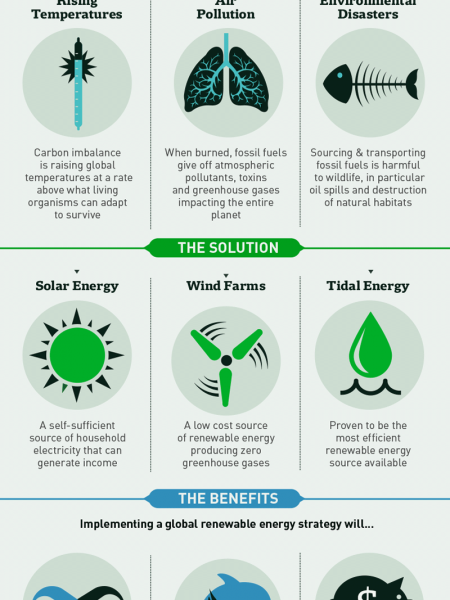
CAN WE END OUR FOSSIL FUEL ADDICTION BY 2050?
HOW CAN WE END OUR FOSSIL FUEL ADDICTION BY 2050? Since the Industrial Revolution, the world has been hooked on fossil fuels. And this fatal addiction has us living on borrowed time, facing ecological and economic ruin by 2050. But it's not too late - if we take the right steps, we can beat our addiction. DKI FUTURE'S END If we're unable to wean ourselves off fossil fuels by 2050, what might happen? 70% of coastlines will witness sea-level changes. 5140 heat-related deaths each year, an A global economic loss of £44.38tn ($71tn) on fossil fuels. increase of 257%. Warming and acidification of the oceans, threatening fish populations. RIP At least a 2.4°C rise in global temperature, with potential for a cataclysmic 5°C rise. Agriculture, crop yields and food production would be ravaged. Drought frequency and intensity could dramatically increase. HOOKED ON FOSSIL-FUELS At present, we remain dangerously over-reliant on fossil fuels for power. According to the International Energy Agency, the total shares of global primary energy supply in 2013 were as follows: 36% O oil 26% Gas • 19% Coal • 10% Nuclear 5% Bioenergy • 2% Hydropower 2% Wind, Solar, Geothermal and Ocean Sadly, fossil fuel usage significantly outstrips renewables. THE ENERGY REVOLUTION However, a complete transference to renewables is achievable. According to Greenpeace, the 5 key principles for an energy revolution are: Creating greater equity in the use of resources Respecting the environment's natural limitations Phasing out unsustainable energy sources ECLOSED Implementing renewable solutions, i.e. decentralized energy systems and grid expansions Decoupling economic growth from the consumption of fossil fuels (Greenpeace, 2014) If these criteria are met, then we can end our fossil fuel addiction by 2050: Share of electricity production Renewable energy sources A Fossil fuels & nuclear energy 2020 2030 2050 97% 71% 63% 37% 29% 3% A CLEAN FUTURE BY 2050 With minimal investment costs, the energy revolution could save £3,812bn* ($6,100bn) by 2050 through divestment from fossil fuels. To achieve this, we can take the following steps: 1 TAP GEOTHERMAL POWER Energy provision: 6.67% 46,100 - directly employed by 2030 (US) € €479.56 investment for max output from generator S £174.31 maintenance costs per kilowatt year Environmental benefits: Geothermal plants produce 99% fewer CO2 emissions and 97% less acid-rain producing chemicals than fossil fuel plants. 2 INVEST IN WIND POWER Energy provision: 36.29% 160,300 - directly employed by 2030 (US) € £1,102.522 investment for max output from generator O €52.112 maintenance costs per kilowatt year Environmental benefits: Improvements in air quality could save £224.43-550.1bn in fossil fuel-related health problems. 3 BUILD SOLAR PLANTS ergy provision: 45.66% 343,800 – directly employed by 2030 (US) € €1,779.33*2 investment for max output from generator O £68.862 maintenance costs per kilowatt year Environmental benefits: 3.9 million exajoules of solar energy is absorbed by the Earth's atmosphere each year. Current worldwide power usage is 500 exajoules (2013). 4 USE BIOMASS FOR ENERGY Energy provision: 1.72% 117,500 – directly employed by 2030 (US) € £1,575.522 investment for max output from generator O £123.862 maintenance costs per kilowatt year Environmental benefits: The average UK home could save 14.5 tonnes of Co2 emissions per year through biomass-fuelled heating. 5 HARNESS OCEAN POWER Energy provision: 5.06% 14,500 - directly employed by 2030 (US) £ £1,575.24 investment for max output from generator £42.18 maintenance costs per kilowatt year Environmental benefits: Tidal current power offers 180 TWh/year of exploitable energy worldwide, saving 124,119,180 tonnes of CO2 from fossil fuels. 6 BUILD HYDROELECTRIC PLANTS Energy provision: 4.57% 13,000 - directly employed by 2030 (US) € £2,425.85 investment for max output from generator £96.79 maintenance costs per kilowatt year Environmental benefits: Only generates 0.1-0.5lbs of CO2, compared with 0.6-2lbs from natural gas. Climate change is real - the threat to food production alone demands a change to energy provision. We may have the technology, but we still lack the vision. To safeguard the future, we must spark an energy revolution. NOTES *1 All financial information has been converted from USD to GBP. Conversion rate correct as of 29 October 2014 *2 Figures are mean total from subcategories of renewable power sources *3 Or 2.5-6% of US domestic GDP SOURCES To view our sources for this infographic go to: arbtech.co.uk/can-we-end-our-fossil-fuel-addiction-2050 ARBTECH ARBTECH.CO.UK IINNNN
CAN WE END OUR FOSSIL FUEL ADDICTION BY 2050?
Designer
Inside OnlineSource
https://arbt...tion-2050/Category
EnvironmentGet a Quote









